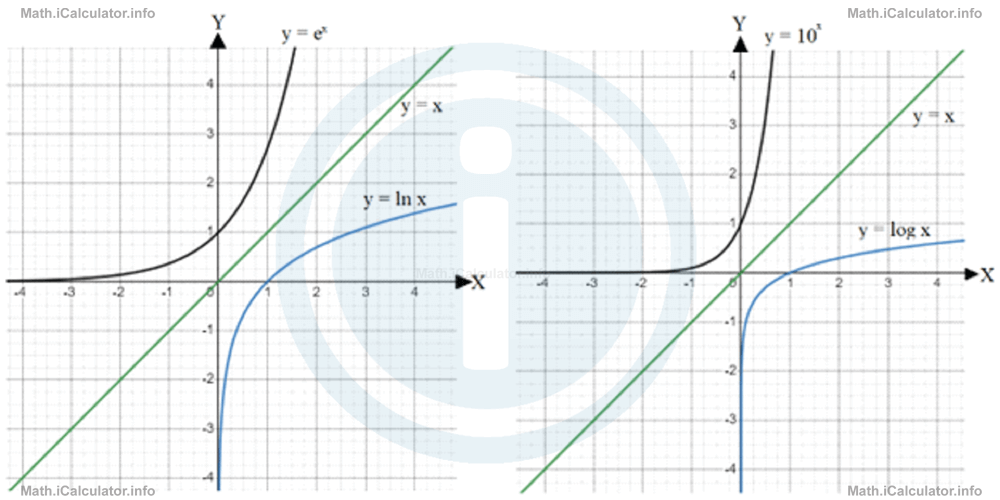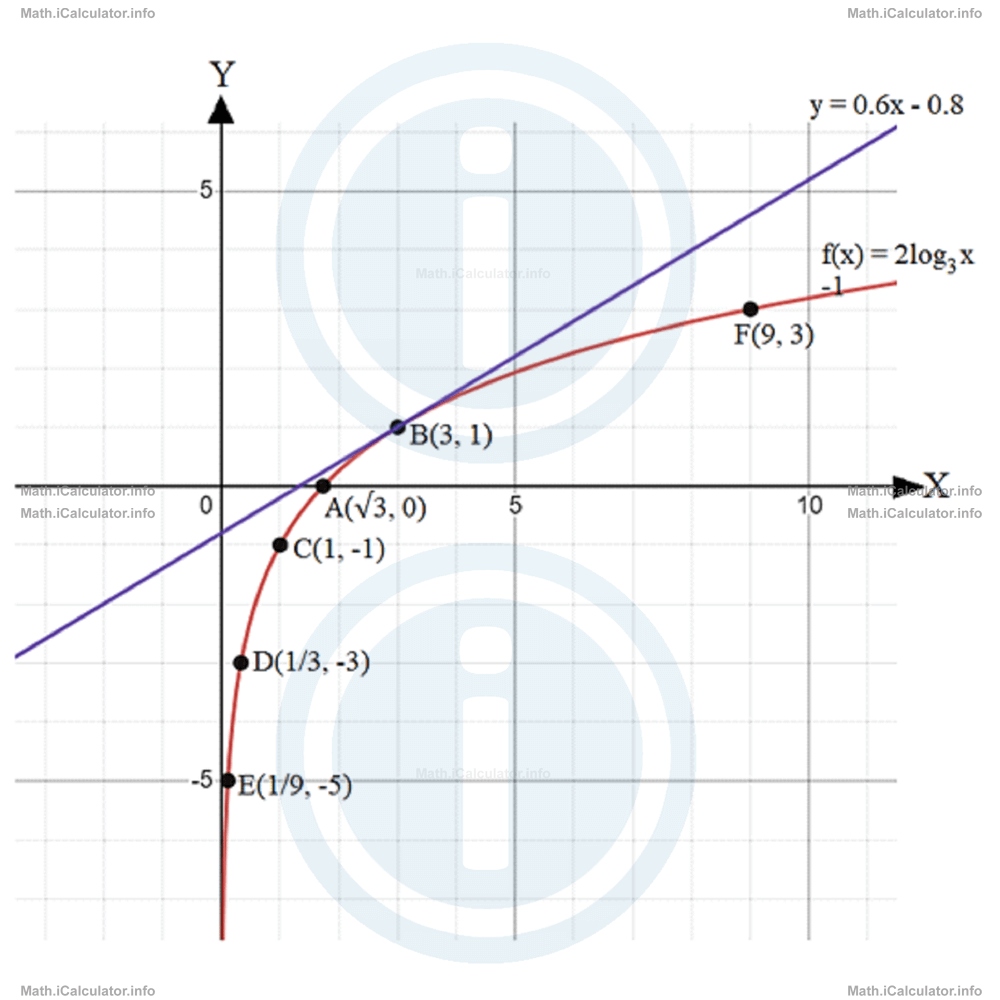Menu
Math Lesson 16.3.5 - Logarithmic Function
Please provide a rating, it takes seconds and helps us to keep this resource free for all to use
Welcome to our Math lesson on Logarithmic Function, this is the fifth lesson of our suite of math lessons covering the topic of Basic Functions, you can find links to the other lessons within this tutorial and access additional Math learning resources below this lesson.
Logarithmic Function
In chapter 13, we have dealt with logarithmic functions in the sense that we explained that they are the inverse of exponential functions. We have also explained that a logarithmic function f(x) = loga x is the inverse of an exponential function with base a, where the variable x in logarithmic functions is in the part known as an argument. When the base of an exponential function is the Euler number 'e', the corresponding logarithmic equation is called the natural logarithm (in short 'ln') function. Hence, the above pairs of functions are the inverse of each other. We explain in tutorial 16.5 that the inverse of a function f(x) is denoted as f - 1(x). Using this notation, we can express the relationship between exponential and logarithmic functions as:
f(x) = logex = lnx ⟹ f-1 (x) = ex
The graph of a logarithmic function (but not only; this rule is available for all functions) is symmetrical to its corresponding exponential function with respect to the line y = x. Look at the figure below.

There is an agreement between mathematicians to consider only logarithmic functions with a positive base because this corresponds to exponential functions with a positive base. We explained earlier in this tutorial that if the base of an exponential function is positive, the value of the function switches between positive and negative depending on whether the exponent x is even or odd. Hence, we are not able to obtain a graph for this function.
From the figure above, it is clear that logarithmic functions have no y-intercepts as they do not touch the Y-axis. Logarithmic functions have only x-intercepts, which for logarithmic functions of the form f(x) = logax is always at (1, 0). Therefore, to plot the graph of a logarithmic function we give other 4-5 values to the variable x, where some are between 0 and 1 and the rest are greater than 1. Then, we connect these points smoothly.
The gradient of the logarithmic function f(x) = loga x is
(We will explain how to find the gradient when dealing with derivatives.)
In this way, we can obtain the equation of the tangent line at any point of the graph as in the previous example.
As for the domain and range, it is clear that the domain of logarithmic functions includes only the positive numbers. Hence, we have D = (0, + ∞). On the other hand, the range of a logarithmic function has no restrictions; it can be positive, negative or zero depending on the values of the independent variable x.
Example 5
For the logarithmic function
find:
- Domain and range.
- Intercept(s) of the graph with the axes.
- Gradient at x = 9.
- The equation of tangent line at x = 3.
- Plot the graph of f(x) including any asymptote(s) and the tangent line found in (d).
Solution 5
- The domain of a logarithmic function includes all positive numbers because the argument of a logarithm cannot be negative. Thus, D = (0, + ∞).
As for the range, it includes all numbers - positive and negative. Therefore, the range includes all real numbers [R = (-∞, + ∞)]. - The x-intercept is obtained for f(x) = 0. Thus 0 = 2log3 x - 1Therefore, the x-intercept is at A(√3, 0).
2log3 x = 1
log3 x = 1/2
x = 31/2
x = √3
The y-intercept is obtained for x = 0. This is not possible, as log3 0 is not defined. Therefore, this function has no y-intercepts. We say the y-axis (with equation x = 0) is a vertical asymptote for the function f(x). - Given that the equation of gradient m of the parent logarithmic function f(x) = loga xism = 1/x ∙ lnathen, the gradient of the functionf(x) = 2log3 x - 1ism = 2/x ∙ ln3For x = 9, the gradient m ism = 2/9 ∙ ln3
= 2/9 ∙ 1.1
= 2/9.9
= 0.2 - First, we use the same procedure as in (c) to find the gradient at x = 3. We have m = 2/x ∙ ln3Hence, the equation of the tangent line at x = 3 will be
= 2/3 ∙ ln3
= 2/3 ∙ 1.1
= 2/3.3
= 0.6y = 0.6x + nwhere n is a constant to be calculated. For this, we find f(3) in the original function, as it corresponds to the y-coordinate of the tangency point. Thus,f(3) = 2log3 3 - 1Therefore, since B(3, 1) is also a point of the tangent line, we have
= 2 ∙ 1 - 1
= 2 - 1
= 11 = 0.6 ∙ 3 + nHence, the equation of the tangent line to f(x) at x = 3 is
1 = 1.8 + n
n = -0.8y = 0.6x - 0.8 - We have so far identified only two points of the graph: A(√3, 0) and B(3, 1). We need more points to plot the graph because the logarithmic graph is a curve. For example, for x = 1, we have f(1) = 2log3 1 - 1Hence, we have another point of the graph identified: C(1, -1).
= 2 ∙ 0 - 1
= 0 - 1
= -1
Yet, for x = 1/3, we havef(1) = 2log3 (1/3) - 1Hence, point D(1/3, -3) is another point of the graph.
= 2log3 1 - 2log3 3 - 1
= 2 ∙ 0 - 2 ∙ 1 - 1
= -2 - 1
= -3
We continue this way to identify two other points: )E(1/9, -5 obtained for x = 1/9 and F(9, 3) obtained for x = 9. In this way, we obtain the following graph after inserting all the above points and joining them smoothly.
You have reached the end of Math lesson 16.3.5 Logarithmic Function. There are 8 lessons in this physics tutorial covering Basic Functions, you can access all the lessons from this tutorial below.
More Basic Functions Lessons and Learning Resources
Whats next?
Enjoy the "Logarithmic Function" math lesson? People who liked the "Basic Functions lesson found the following resources useful:
- Logarithmic Feedback. Helps other - Leave a rating for this logarithmic (see below)
- Functions Math tutorial: Basic Functions. Read the Basic Functions math tutorial and build your math knowledge of Functions
- Functions Revision Notes: Basic Functions. Print the notes so you can revise the key points covered in the math tutorial for Basic Functions
- Functions Practice Questions: Basic Functions. Test and improve your knowledge of Basic Functions with example questins and answers
- Check your calculations for Functions questions with our excellent Functions calculators which contain full equations and calculations clearly displayed line by line. See the Functions Calculators by iCalculator™ below.
- Continuing learning functions - read our next math tutorial: Composite Functions
Help others Learning Math just like you
Please provide a rating, it takes seconds and helps us to keep this resource free for all to use
We hope you found this Math tutorial "Basic Functions" useful. If you did it would be great if you could spare the time to rate this math tutorial (simply click on the number of stars that match your assessment of this math learning aide) and/or share on social media, this helps us identify popular tutorials and calculators and expand our free learning resources to support our users around the world have free access to expand their knowledge of math and other disciplines.